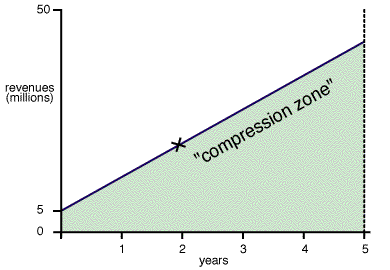Overview
An entrepreneur that can build a venture may not be ideally suited to maintain the company during its maturity. An Andersen executive describes the challenges that many successful entrepreneurs face.
The Trade-Off Game: For Entrepreneurs Ages 18 and Up
Apple, Lotus, Powersoft, Smartfoods, Snapple, Subway … The list transcends industry and is tireless.
Hundreds of today’s best known companies have a common mark. At some crucial growth crossroads, new management entered the scene – one way or another – to supplement or replace the idea person or people. They came to help the company make the transition from being small and successful to being big and successful. With some regularity this milestone is reached because the entrepreneur is not always the best chief executive; often he or she is ill-equipped to take the company to the next level. The visionary and the manager have different skill sets, different styles, different interests.
It has become conventional wisdom among entrepreneurs that one of the most common – and harmful – mistakes a founder can make is to not honestly evaluate what his or her role should be as a company leaves the runway. As an entrepreneur, then, you need to ask yourself: “Do I know how to fly” or even “Do I like flight?”
At some point during the early stages of growth, founders need to determine their company’s goals and decide what their role should be as the company works towards those goals. Many founders rely on customized evaluation tools to guide them through this process. One such tool is called the “Trade-Off Game.” This exercise helps entrepreneurs better understand their interests and aptitudes and how their talents compare with the company’s needs. But to play the game correctly, the company must have a sense of what and where it wants to be in five years.
Five Years From Today This Company Will Be…
A fundamental first step in the evaluation process is for the founder to articulate his or her longer-run business goals or vision. Not to be confused with detailed business planning, the vision merely sets out where you want to be in terms of growth and exit strategy in the not-that-distant future. Here are two five-year growth scenarios:
1. Growth from a successful $5 million company to an equally successful $10 million concern. While 100% growth is not to be achieved easily, it is likely in this scenario that the entrepreneur retains a large share of management responsibility for the company. He or she has more of a marketing and sales challenge (and hiring need) than a completely new set of business management pressures.
2. $5 to $50 million in 60 months or 5,900% growth in five years. This scenario represents a cultural and organizational revolution. In this wild equity market the presumption is that the company will be positioning itself for its launch into public ownership – a launch that will burn capital and quickly test the managerial fitness of the founder.

The chart above depicts the compression zone for growth. The steeper the growth curve, the greater the pressure placed on the organization, its capital and its people. In high growth situations like scenario number two, it is often essential to look outside the organization for talent capable of positioning the company for sustainable high growth. Moreover, the founder in a situation like this may need to relinquish day-to-day managerial responsibility. Where do you find the right talent? The X on the chart suggests the minimum revenue size at which the founder may need to recruit experienced executives from another organization – presumably executives that have managed the compression zone wisely and well.

